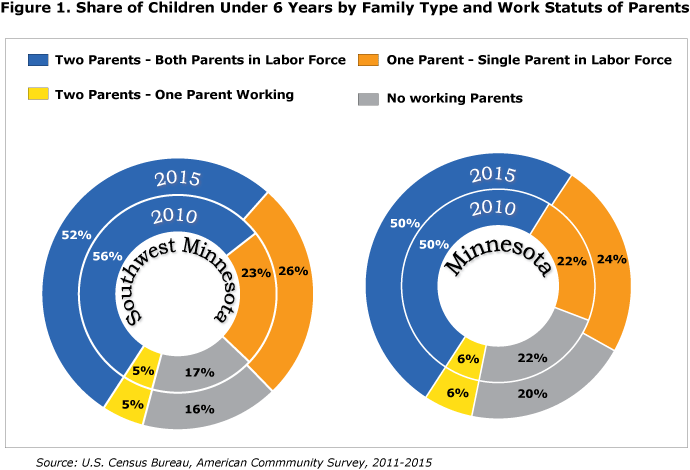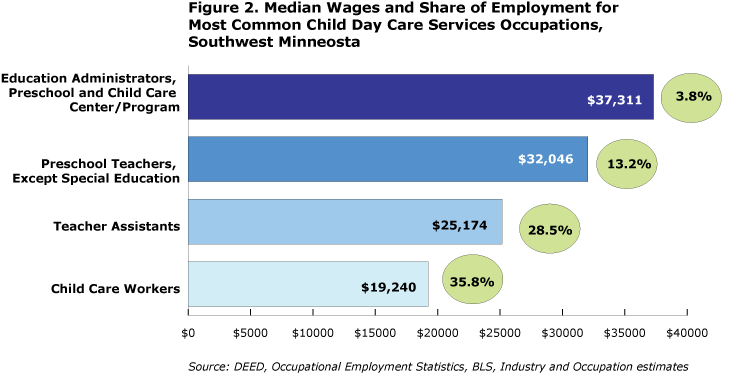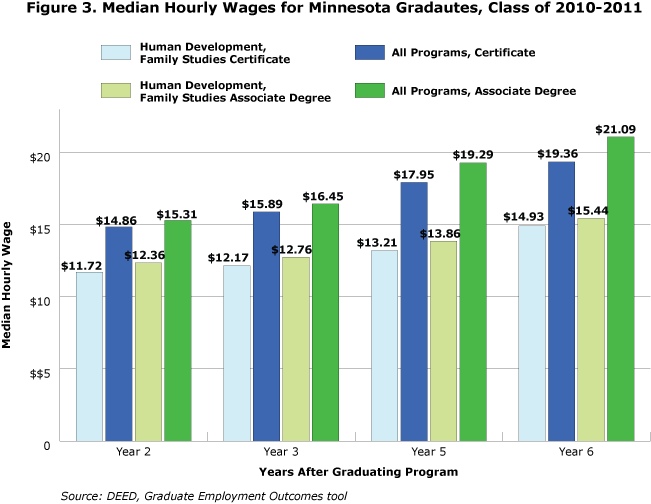by Luke Greiner and Mark Schultz
March 2017
The economic cost of having children has been tallied and reported for years, with the latest data from the USDA’s Center for Nutrition Policy and Promotion estimating that raising a child through the age of 17 costs $233,610 for a married, middle-income (gross household income between $59,200 and $107,400) couple with two children.1 This includes costs for housing, food, transportation, clothing, health care, education, and miscellaneous expenses, many of which increase as the number of children in the household increases.
For many families one of the other major costs in that equation is child care. Child care is an important issue in Southwest Minnesota, which is home to about 89,000 children under the age of 18, accounting for just under 23 percent of the entire population. Depending on the composition and work status of the family, the cost of child care in Southwest Minnesota can be daunting.
For families with two or more children, the Cost of Living data tool defines the third child as aged 13 and the fourth child aged 14-18 years, both being ages that can take care of themselves, hence the cost of child care does not rise for families with more than two children.
For example, as seen in Table 1, for both a single person and a two-parent family where the adults are working full-time while raising two children, the cost of childcare is $639 per month based on estimates from DEED’s Cost of Living data tool. To put that into perspective, for a family with a gross household income of $59,200 as mentioned above, that’s approximately 13 percent of their gross monthly income. That is very real in Southwest Minnesota, where median incomes for families with children under 18 years of age ranged from $52,375 to $72,817 in 2015 according to Census data.
| Table 1: Cost of Child Care in Southwest Minnesota | |||
|---|---|---|---|
| Household Composition | Number of Children | Work Status | Monthly Cost of Child Care |
| Single | 1 | FT | $429 |
| Two or more* | $654 | ||
| Two-Parent | 1 | 1 FT / 1 PT | $214 |
| Two or more* | $327 | ||
| Two-Parent | 1 | 2 FT | $429 |
| Two or more* | $654 | ||
| * For families with two or more children, the Cost of Living data tool defines the third child as aged 13 and the fourth child aged 14-18 years, both being ages that can take care of themselves, hence the cost of child care does not rise for families with more than two children. | |||
| Source: DEED Cost of Living tool | |||
Child care costs are lower for a two-parent household where one adult is working part-time, assuming that the adult working part-time is caring for the children when not at work, essentially cutting costs. But the biggest cost burden for child care falls on single-parent households, especially female households, which had median incomes as low as $18,542 in Pipestone County to a high of $43,542 in Watonwan County. For a female householder with two children needing child care, those costs would account for between 20 and 40 percent of her income at the median.
What's more, these estimates may be a bit low as the cost for private child care may be higher, and rates for infants are usually higher than those for a toddler. Costly and limited child care openings in Southwest Minnesota have created circumstances where parents can't find child care, reducing their availability to work. This is leading some parents to opt out of the workforce in order to stay at home to care for their children to avoid having to pay the high price tag for child care, or, possibly, limiting their notion to have more children.
Either way, these missed employment opportunities may be presenting an even bigger cost to the region. With a tight labor market and an aging population, Southwest Minnesota can't afford either option. Both current and future labor force participants are at a premium in a region of the state that has low unemployment rates, large numbers of unfilled jobs (currently there are just under 6,600 vacancies according to DEED's Job Vacancy Survey), and a pool of workers that is expected to shrink in the next decade.
There were just 1.3 jobseekers per vacancy in Southwest Minnesota in 2016, and the region's labor market demographics are expected to worsen as Baby Boomers start leaving the workforce in higher numbers than new workers will be entering. According to population projections from the Minnesota State Demographic Center, the number of 65 to 74 year olds is expected to jump by over 25,500 people, while the region is expected to see a decline of 3,800 people between the ages of 15 and 24.
In 2015 the majority of children under six years old in Southwest Minnesota were living with two parents, although the percentage has been going down over time. As described above, two-parent households have the option of having both adults working and increasing the family income or having one parent work part-time or stay at home to take care of the young children. However, that benefit hinges on high enough wages for the single worker to allow the other parent to stay home, or, if both parents are working, the availability of child care.
Census data shows that 52 percent of all children under six years old in Southwest Minnesota live in homes where both parents were in the labor force, although that was a drop from 56 percent in 2010. Still, the share of young children under the age of six with two working parents is higher in Southwest than the state of Minnesota (50 percent). Much like working single parents, families with two parents working depend on childcare in order for both to work.
Although difficulties finding child care might seem dire for families with two working parents, it's more problematic for single parents. Without reliable and affordable child care for single parents, full-time employment and self-sufficient living are likely out of reach since they don't have the option of having one parent stay home. Twenty-six percent of the youngest children in Southwest Minnesota live with a single parent who works, which was up from 23 percent in 2010, changing faster and ending higher than the rest of Minnesota (see Figure 1).

Overall, parents of small children have high labor force participation rates. For two-parent households with young children, the participation rate was 75 percent in 2015, and for single parents with young children, it was even higher at 85 percent – both compared to the 69 percent participation rate for the total population aged 16 years and over in Southwest Minnesota. The participation rates for these parents are on par with all people between the ages of 25 to 44 years, where 89 percent are in the labor force.
While the economic complications surrounding the cost and availability of child care might be felt by working parents, they are also felt by the employers they either work for or used to work for. The root cause may be found in the child care employers themselves. According to a recent article by Marnie Werner at the Center for Rural Policy and Development that highlighted the issues of child care in Minnesota, "For child care centers, 70% of the cost of operation is in staff."2
Ironically, even though labor costs for center-based child care are high, the wages earned by childcare workers are low. Almost 36 percent of all jobs in the child day care services industry are childcare workers, a notoriously low paying occupation with median annual wages in Southwest Minnesota just over $19,000 (see Figure 2).

However, high demand for these workers in the region is starting to push wages up slightly. The median wage offer for childcare workers in Southwest Minnesota rose to $10.04 per hour in the second quarter of 2016. Although that was 89 cents less than the typical starting wage offer for childcare workers in the rest of Minnesota, the offer was actually higher than the median wage earned by those already actually working as childcare workers, which currently rests at $9.25.
Another indicator of the high demand for childcare workers in Southwest Minnesota is the job vacancy rate, a ratio of unfilled openings to total jobs for the occupation. The overall job vacancy rate in the region was 3.7 percent in the second quarter of 2016, but the rate for childcare workers was 18.7 percent. Childcare workers are also among the occupations receiving five stars – the highest demand ranking – in Southwest Minnesota according to DEED's Occupations In Demand tool.
The problem finding childcare workers is probably not because there is a "skills gap" or lack of applicants with enough education. Job Vacancy data shows that previous work experience is not typically required (11 percent of openings), and only 5 percent of openings asked for any type of certificate or license. Instead, low education and prior work experience requirements should help entry into childcare worker positions. In fact, only 2 percent of job openings for child care workers in Southwest Minnesota required any post-secondary education, less than the 8 percent for statewide openings.
However, many workers in the industry decide to pursue postsecondary education. In Minnesota 57.4 percent of childcare workers have attended at least some college, including 11 percent who have associate's degrees and 14 percent who have bachelor's degrees or higher. Data from DEED's Graduate Employment Outcomes tool show that the number of graduates in child care-related programs has been increasing in recent years, despite no demonstrated increase in requirements from employers.
An average of 340 graduates earned certificate and associate degrees in human development and family studies (which includes child care provider and support services management programs) in the two most recent years for which data are available, including 2013-2014. That is up from 300 graduates in the 2010-2011 school year. Data show that most of those graduates ended up working in the social assistance industry sector that includes child day care services, but most failed to earn even $13 per hour two years after graduating.
Even six years after graduating with certificates or associate degrees most childcare workers still earned relatively low wages. It's possible that some graduates from child care-related programs find success and promotions, but the wage growth is nominal at best, especially in comparison to their peers who graduated from other programs (see Figure 3).

Interestingly, demand and educational requirements for childcare workers are similar to fast food worker openings in the region. Wages are low for childcare workers, but so are the wages at fast food establishments, yet that hasn't stopped restaurants from finding new workers and opening new businesses. Median hourly wages and typical starting wages offered for childcare workers are actually higher than the combined food preparation and serving worker occupation, the most common job in the fast food industry.
But unlike fast food establishments, child day care centers operate mainly during the time school is in session. As a consequence, only 3 percent of jobs at child day care centers are held by 14 to 18 year olds, compared to 20 percent for eating and drinking establishments. While restaurants can find a lot of high school students to work enough shifts to keep expanding, child day care services are not able to tap into that workforce pipeline.
Without access to teenaged job seekers who have lower wage expectations, child care employers may be finding that they need to adjust their wages to be less in line with fast food workers, and more like industries not staffed by large concentrations of high school students. However higher wages would likely make child care unaffordable for many parents, meaning child care availability and affordability will likely remain a vexing problem for many working families in Southwest Minnesota.
1Lino, M., Kuczynski, K., Rodriguez, N., and Schap, T. (2017). Expenditures on Children by Families, 2015. Miscellaneous Publication No. 1528-2015. U.S. Department of Agriculture, Center for Nutrition Policy and Promotion.
2Werner, Marnie. "A Quiet Crisis: Minnesota's Child Care Shortage." September 2016.